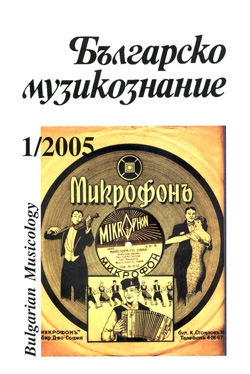Подходи за описване на звукозаписите във фон
Methods of Describing the Phonic Records in the Archive
Author(s): Ivan KumichinSubject(s): Music
Published by: Институт за изследване на изкуствата, Българска академия на науките
Summary/Abstract: The first songs (text and melody) recorded from different regions of Bulgaria date back to the end of 19 century. The lack of sound recording technology at that time was the reason for the note and word text being recorded during the very performance of the singers. That was the manner of collecting and recording the song material until the end of the 1930s. In 1938 R. Katsarova made the first recordings upon gramophone records. Together with documenting the song material it was necessary to process, classify and systematize it. Specially printed notebooks were introduced where all questions connected with the research activity were written down most thoroughly. From 1954 the recording of folk songs and instrumental melodies started to be made on tapes. Another kind of describing was introduced. It was adopted that the box of each tape should have a list of the music recordings it contained. On a long and narrow sheet of paper there is a typed list stating the place, the first verse of each song and the titles of the instrumental melodies. The recordings of each place start with No.1, irrespective of the fact that the numeration of the recording from a new place is in the middle of the tape or continues on another tape. The performers’ names were not always given. Aiming to introduce more clarity and better order a new system of describing was introduced in the second half of the 1960s. In it the descriptions were in two copies - one was folded in the box of the tape, whereas the other was preserved in the verbal archives. In this system we have a comparatively complete description. The necessity of using the same methods of documentation arose in the 70s -by preparing an universal catalogue intended to serve as an auxiliary apparatus for solving various scientific problems. It offered complex treatment of the sound fund and the description of each recording was found by several indices. The inventories were in three typed copies providing the possibility of making up several catalogues. The contemporary status of the phonic archives sets new problems and tasks. One of them is to make the old archival records digital. The aim is that the treatment of the folklore-music material should make it available to future generations.
Journal: Българско музикознание
- Issue Year: 2005
- Issue No: 1
- Page Range: 118-129
- Page Count: 12
- Language: Bulgarian
- Content File-PDF

